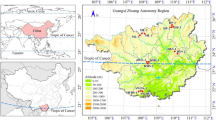Summary
Two series of experiments are reported which determined the origins of above-ground stems in potato crops in Cambridge and elsewhere in East Anglia. Very little secondary branching was found so that counts of above-ground stems and main stems were very similar. The implications of this lack of branching are discussed and the above-ground stem count suggested as a suitable method of recording densities in the potato.
Zusammenfassung
Es wird über eine Anzahl Feldversuche aus den Jahren 1969–1971 berichtet, bei denen der Ort des Beginns obrirdischer Stengel in Kartoffelbeständen bestimmt wurde. Die Versuche wurden in Cambridge und andern Teilen von East Anglia durchgeführt und umfassten verschiedene Bodentypen, das Auspflanzen von Hand und mit der Maschine, die Anwendung von Bodenherbiziden und das Hacken von Hand zur Unkrautbekämpfung, verschiedene Pflanzabstände (30,5–68,6 cm) in der Reihe und zwischen zwei Reihen (68,6 cm und 76,2 cm), viele Sorten und Pflanzknollen verschiedener Grösse mit einer breiten Skala der Keimentwicklung. Die Pflanzen wurden im Juli von Hand geerntet und die Haupttriebe sowie sämtlichte Triebe über dem Boden gezählt. Sehr wenig sekundäre Verzweigungen (Nebentriebe) wurden gefunden (Tabellen 1–4), so dass die beiden Zählmethoden sehr ähnliche Resultate brachten. Selbst bei Pflanzen mit 10 oder 12 Stengeln stammte die Mehrheit der Stengel aus einer Gewebemasse des Kronenendes der Knolle, und es war ohne eingehende Analyse nicht möglich zu bestimmen, wieviele Augen dazu beitrugen; alle diese Stengel wurden deshalb als Haupttriebe gezählt. Viele der sekundären Triebe (Nebentriebe) trugen Knollen (Abb. 1), und es wird angenommen, dass das Zählen aller Stengel über dem Boden eine zuverlässige und nicht einseitige Methode zur Feststellung der Dichte in Kartoffelbeständen ist.
Résumé
Les auteurs rapportent les résultats d'un certain nombre d'expériences visant à déterminer l'origine des tiges aériennes dans les cultures de pomme de terre. Les essais ont été exécutés à Cambridge et dans d'autres endroits de l'Est del'Angleterre, et ont impliqué divers types de sol, les plantations manuelle et mécanique, l'utilisation d'herbicides et le sarclage manuel, divers espacements de plants (30,5–68,6 cm) et de buttes (68,6-cm et 76,8 cm), diverses variétés et diverses grosseurs de plants montrant une large variation dans le développement des germes. On arrachait manuellement les plantes en juillet et on déterminait les nombres de tiges au-dessus et en-dessous du sol (tiges principales). On a trouvé une très faible ramification secondaire (tableaux 1–4) de sorte que les deux méthodes de comptage ont donné des résultats très semblables. Même lorsque les plantes montrent 10 ou 12 tiges, celles-ci proviennent en majorité d'une masse de tissu située à la couronne du tubercule et il n'est pas possible sans une dissection minutieuse de préciser combien de bourgeons ont contribué à ce résultat, par conséquent, toutes ces tiges sont considérées comme tiges principales provenant d'en-dessous du sol. Beaucoup de branches secondaires produisent des tubercules (fig. I) et les auteurs pensent que le dénombrement de toutes les tiges audessus du sol constitue une méthode valable et non-subjective de déterminations des densitées dans les cultures de pomme de terre.
Similar content being viewed by others
References
Bleasdale, J. K. A., 1965. Relationship between set characters and yield in maincrop potatoes.J. agric. Sci. Camb. 64: 361–366.
Burton, W. G. & A. R. Wilson, 1970. The apparent effect of the latitude of the place of cultivation upon the sugar content of potatoes grown in Great Britain.Potato Res. 13: 269–283.
Goodwin, P. B., A. Brown, J. H. Lennard & F. L. Milthorpe, 1969. Effect of centre of production, maturity and storage treatment of seed tubers on the growth of early potatoes. II. Field growth.J. agric Sci., Camb. 73: 167–176.
Gray, D., 1971. The production of potatoes for canning.ADAS. Q. Rev. 1: 24–30.
Gray, D. & J. K. A. Bleasdale, 1971. The production of potatoes for canning. Potato Marketing Board Publication.
Holliday, R., 1960. Plant population and crop yield, Part II.Fld. Crop Abstr. 13: 247–254.
Holmes, J. C., 1966. The effect of cultivations, herbicide and weed control on potatoes.Expl Husb. 14: 75–82.
Holmes, J. C., R. W. Lang & A. K. Singh, 1970. The effect of five growth regulators on apical dominance in potato seed tubers and on subsequent tuber production.Potato Res. 13: 342–352.
Holmes, J. C. & D. Gray, 1971. A comparison of desprouted and late sprouted seed potatoes in relation to apical dominance and tuber production.Potato Res. 14: 111–118.
Krijthe, N., 1955. Observations on the formation and growth of tubers of the potato plant.Neth. J. agric. Sci. 3: 291–304.
Milthorpe, F. L., 1963. Some aspects of plant growth. An introductory survey. In: J. D. Ivins & F. L. Milthorpe (Ed.), The growth of the potato. Butterworths, London.
Owadally, A. L. & P. M. Bremner, 1967. Some aspects of seed tuber production in potatoes.Rep. Sch. Agric. Univ. Nott. 1966–67: 67–72.
Author information
Authors and Affiliations
Rights and permissions
About this article
Cite this article
Allen, E.J., Wurr, D.C.E. A comparison of two methods of recording stem densities in the potato crop. Potato Res 16, 10–19 (1973). https://doi.org/10.1007/BF02360588
Accepted:
Issue Date:
DOI: https://doi.org/10.1007/BF02360588




